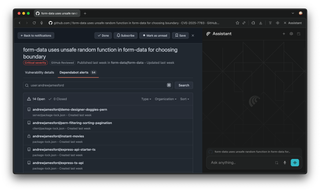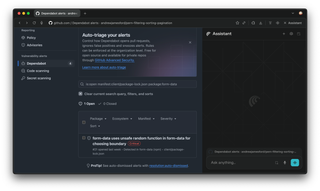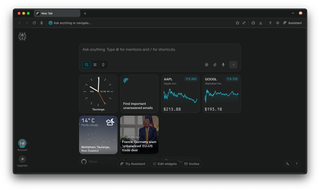If you’re like most developers, you’ve probably found yourself drowning in GitHub security notifications. Those endless email alerts about vulnerable dependencies, the mounting pile of Dependabot pull requests, and the tedious process of reviewing and updating packages across multiple repositories can quickly become overwhelming. But what if I told you there’s a way to automate almost all of this using AI-powered tools?
GitHub notifications interface showing filtered security and project-related notifications across multiple repositories.
Recently, I discovered a workflow that has transformed how I handle GitHub security maintenance using Comet (Perplexity’s AI browser) and GitHub Copilot. This combination has turned what used to be hours of manual work into a streamlined, automated process that runs in the background while I focus on more meaningful development tasks.
The Problem: Security Notification Overload #
Let me paint a familiar picture. You open your GitHub notifications and see dozens of security advisories waiting for attention. Each one represents a repository that needs dependency updates, usually with a Dependabot pull request already generated but still requiring human review, testing, and merging.

GitHub dependency graph showing alerts for known security vulnerabilities in project dependencies and suggested updates.
In my case, I had 15 different projects sitting there, each with its own security issues that needed addressing. While tools like Dependabot do a relatively good job of identifying vulnerabilities and creating initial pull requests, you still need to review each one, ensure tests pass, and manually merge the changes.
The traditional manual process looks something like this:
- Identify outdated dependencies across all repositories
- Review security advisories and determine update priorities
- Manually update dependency versions
- Create pull requests and wait for CI/CD tests
- Review and merge each pull request individually
For developers managing multiple projects, this process could easily consume days of development time every few weeks.

Enter Comet: Your AI-Powered Browser Assistant #
Comet is Perplexity’s revolutionary AI browser that transforms how we interact with web applications. Unlike traditional browsers, Comet can understand the context of what you’re viewing and take actions on your behalf. It’s designed to collapse complex workflows into simple, conversational interactions.

Screenshot showing Perplexity AI answering a philosophical question and Comet AI running a step-by-step guide on building an iPhone app.
What makes Comet particularly powerful for developer workflows is its ability to:
- Navigate browser tabs intelligently and understand page context
- Automate repetitive web-based tasks across multiple platforms
- Create reusable shortcuts for common workflows
- Integrate with GitHub’s interface seamlessly
The key insight here is that Comet treats your browser as an interactive workspace rather than just a document viewer.
The Automated Workflow: From Chaos to Order #
Here’s the workflow I’ve developed that has revolutionized my security maintenance process:
Step 1: Create the Automation Prompt #
I created a comprehensive prompt that instructs Comet to handle my GitHub security notifications systematically. The prompt includes:
Go through these projects, create a new issue for each project with the following title:
"Update dependencies to address security issues"
Description:
"The project currently has security issues related to its
dependencies. Here's the task I want you to do:
- Update all dependencies that have known security issues
- Ensure that the project still builds and passes all tests after updates
- Investigate and update the affected dependencies
- Verify that the application remains stable and secure"
Assign this to GitHub Copilot and make sure any repositories that have not
had recent pull requests made today have issues created.Step 2: Let Comet Navigate and Execute #
Once I trigger this prompt, Comet springs into action:
- Analyzes the current browser tab containing my GitHub security notifications
- Navigates through each project in the security advisory list
- Checks for existing recent pull requests to avoid duplicate work
- Creates standardized issues for projects needing attention
- Assigns each issue to GitHub Copilot for automated resolution
GitHub code scanning alert interface showing a high severity Zip Slip vulnerability and options to dismiss the security alert.
The beauty of this approach is that Comet understands the visual context of the GitHub interface and can navigate it just like a human would, but with perfect consistency and attention to detail.
Step 3: GitHub Copilot Takes Over #
Once Comet creates the issues and assigns them to GitHub Copilot, the AI pair programmer takes over:
- Analyzes the security vulnerabilities in each repository
- Creates draft pull requests with dependency updates
- Runs automated tests to ensure compatibility
- Provides detailed explanations of what changes were made
- Generates ready-to-review pull requests for final approval
A DevOps workflow diagram showing GitHub Actions automation for active development, release, and deploying containers to development, staging, and production environments via CI/CD pipelines.
The Results: Massive Time Savings #
The transformation in my workflow has been remarkable:
Before automation:
- Days of development time every few weeks manually handling security updates
- Frequent delays in applying critical security patches
- Inconsistent approaches across different repositories
- High risk of human error in repetitive tasks
After automation:
- 15 minutes per sprint to review and approve automated updates
- Consistent, systematic approach to security maintenance
- More up-to-date dependencies across all projects
- Significantly reduced security exposure time
This mirrors the experience of other development teams who have seen similar dramatic improvements when automating dependency management.
Creating Reusable Shortcuts #
One of Comet’s most powerful features is the ability to save successful workflows as shortcuts. After running my security automation workflow, Comet prompted me to save it as a reusable shortcut called “GitHub List of Security Projects.”
Now, whenever I need to process a batch of security notifications, I can simply:
- Navigate to my GitHub security notifications
- Trigger the saved shortcut
- Let the automation run while I work on other tasks
This creates a sustainable, repeatable process that scales across any number of repositories.
Why This Approach Works #
The combination of Comet and GitHub Copilot addresses several key pain points in developer workflows:
-
Context Awareness - Unlike traditional automation tools, Comet understands the visual context of web pages and can adapt to interface changes.
-
Human-AI Collaboration - Rather than fully automated black-box solutions, this approach maintains human oversight while automating the tedious parts.
-
Scalability - The workflow scales effortlessly from a few repositories to dozens without additional manual effort.
-
Consistency - Every repository gets the same systematic treatment, reducing the risk of overlooked vulnerabilities.
Best Practices and Considerations #
While this automation is powerful, there are important considerations:
Testing is Critical #
Ensure your repositories have robust automated testing in place. The automation is only as good as your ability to verify that updates don’t break functionality.
Review Before Merging #
While GitHub Copilot does excellent work, always review the generated pull requests before merging, especially for critical applications.
Start Small #
Begin with less critical repositories to build confidence in the automation before applying it to mission-critical systems.
Monitor and Iterate #
Keep track of the automation’s success rate and refine your prompts based on results.
Looking Forward: The Future of Developer Automation #
This workflow represents a glimpse into the future of software development, where AI assistants handle routine maintenance tasks while developers focus on innovation and problem-solving. The combination of browser automation (Comet) and code assistance (GitHub Copilot) creates a powerful synergy that’s greater than the sum of its parts.
As AI tools continue to evolve, we can expect even more sophisticated automation capabilities:
- Predictive dependency management that anticipates security issues
- Intelligent conflict resolution for complex dependency updates
- Automated testing generation tailored to dependency changes
- Smart rollback capabilities when issues are detected
Getting Started #
If you’re interested in implementing this workflow:
- Sign up for Perplexity Max to access Comet (currently in limited release)
- Enable GitHub Copilot on your repositories
- Set up robust automated testing in your CI/CD pipelines
- Start with a few non-critical repositories to test the process
- Gradually expand to your full portfolio of projects
The initial investment in setup pays dividends almost immediately through the time savings and improved security posture.
Conclusion #
The days of manually trudging through dozens of security notifications are behind us. By leveraging AI-powered tools like Comet and GitHub Copilot, we can transform tedious maintenance tasks into automated workflows that run reliably in the background.
This isn’t just about saving time—though the time savings are substantial. It’s about enabling developers to focus on what they do best: solving complex problems, building innovative features, and creating value for users. When AI handles the routine maintenance, human creativity is unleashed for more meaningful work.
The future of software development is collaborative human-AI workflows, and tools like Comet and GitHub Copilot are showing us what that future looks like today.